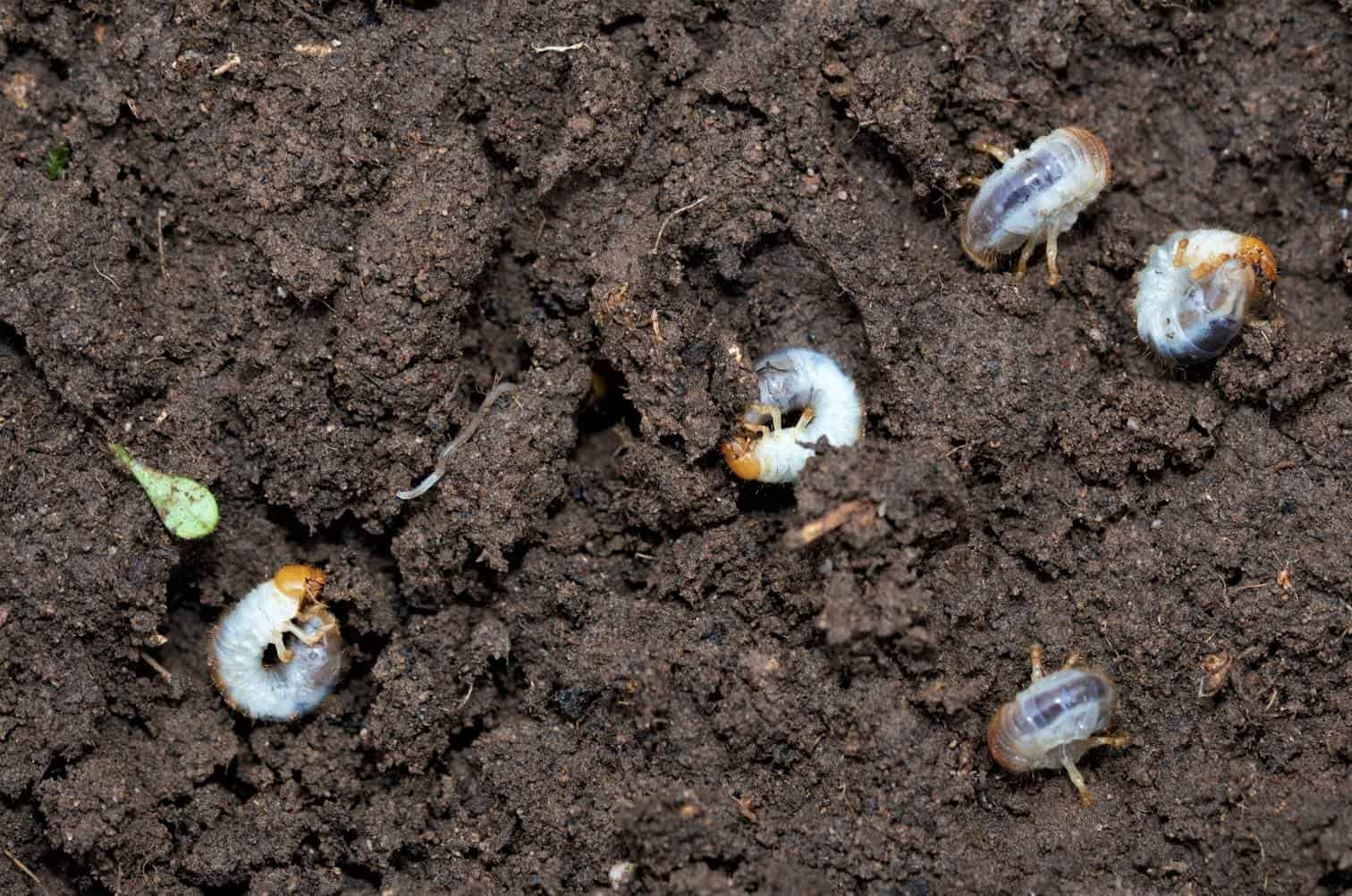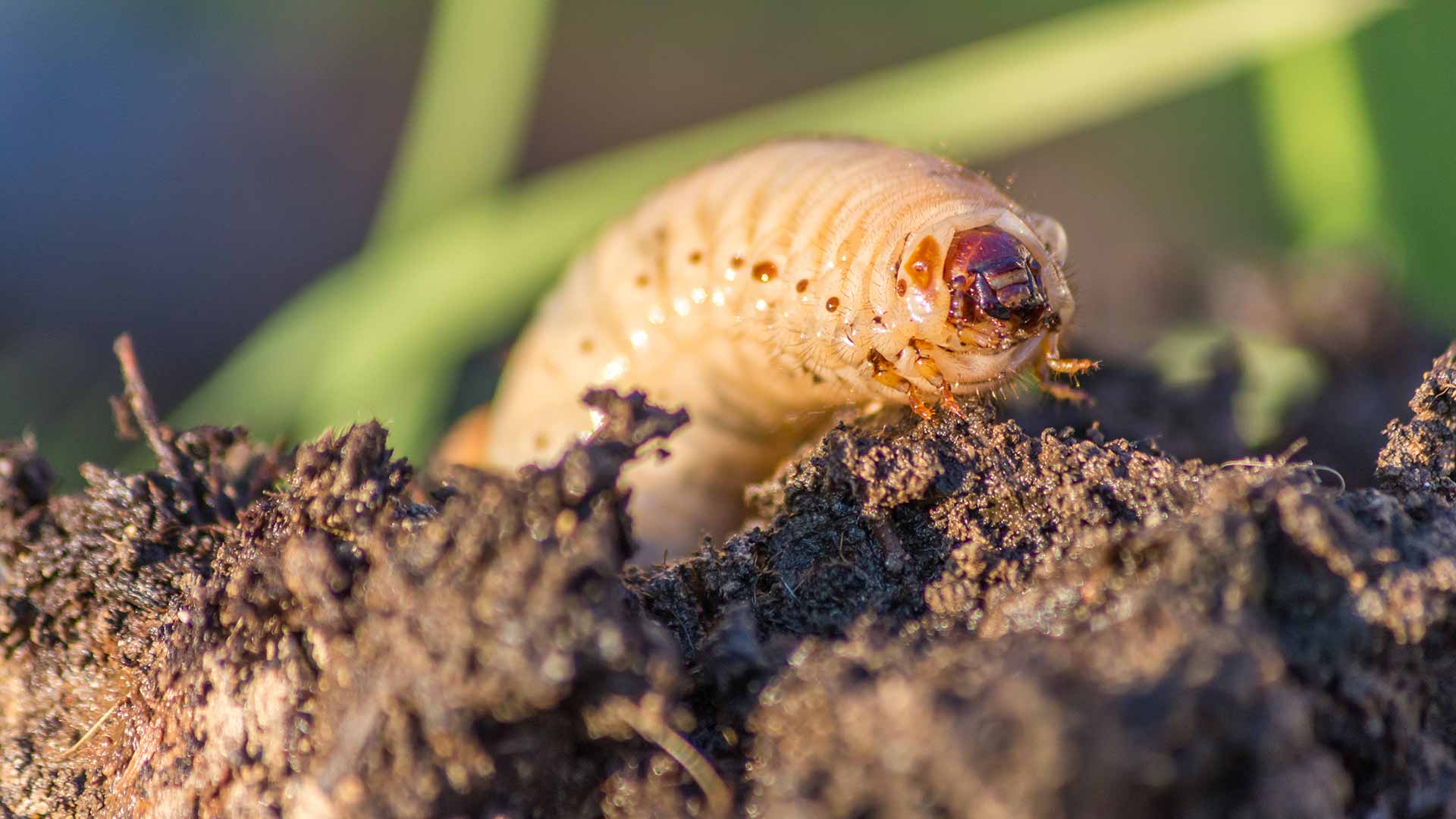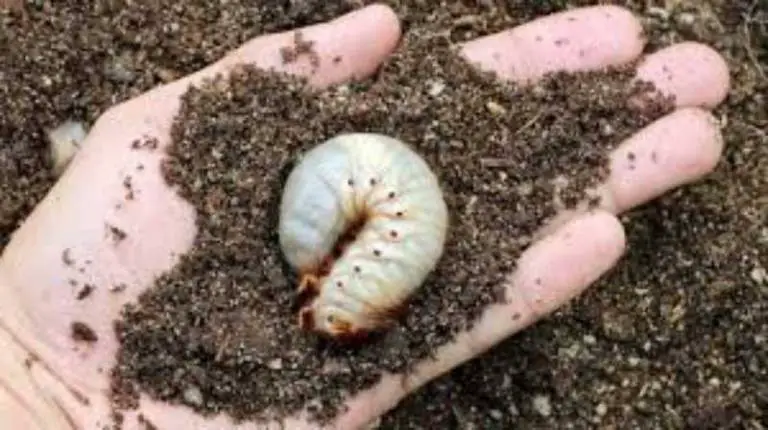How Do You Get Rid Of Grubs Naturally
These include milky spore, neem oil, and nematodes available at most garden centers.
Controlling Grubs In The Lawn
Beetles, like Japanese and chafer beetles, emerge in early summer, feed on plants in the garden, and lay their eggs in the soil in the lawn. Later in the summer, the grubs hatch and immediately begin to feed. They will continue to eat and grow until mid-fall, when they move deeper in the soil so they can survive through the winter. When the soil warms up again in the spring, the large, mature grubs move back into the upper soil levels, where they transform into adult beetles that emerge in early summer and start the whole process over again.
The key to controlling grubs is to kill them before they hatch and begin to cause damage to your lawn. In spring or early summer, apply a preventative grub control product, such as Scotts® GrubEx®1 to your lawn, following label directions. This is especially important if youve had problems with grubs in the past. One application of Scotts® GrubEx®1 can kill and prevent grubs for up to 4 months.
How To Get Rid Of Grubs
Since grubs are a major reason raccoons, skunks and other wild animals are attracted to your lawn, if you want to stop these animals from digging up your yard, you need to know how to get rid of them. Grubs can also damage grass directly by feeding on the roots, which can deprive the grass of important nutrients and result in ugly brown patches, so getting rid of grubs will improve the appearance and health of your grass in several ways.
If you want to know how to get rid of grubs, first you have to know how to identify them. Grubs are the larvae of various types of beetles, both large and small. That means that grubs themselves can be small, about a half-inch long and a quarter-inch in diameter, or surprisingly large . Whether theyre small, large or any size in between, most grubs have fat, banded, C-shaped bodies in a semi-translucent shade of white, yellow or gray. Most also have brown or dark-gray heads, six small legs clustered together close to the head and the rest of their curved bodies extending beyond that.
A quicker option is to eliminate grubs using chemical products designed either to kill off existing larvae or prevent future generations. There are several issues with this approach, however. Using harsh chemicals in your yard will kill off all kinds of insects, including beneficial ones. Chemicals can also pose a threat to anyone who spends time in the yard, including children and pets.
So, are there other options to prevent animals from digging in your yard?
Don’t Miss: Will Vinegar Kill Dallisgrass
To Deter Lawn Grubs Dethatch
But what are the most effective options for sustainable-minded lawn owners?
Preventive methods top Shetlars list for fighting grubs nonchemically. I emphasize a lot especially to lawn care and sport field managers to keep the thatch down to a minimum, Shetlar said. His key to this: fertilizing ones lawn with nitrogen only once per year, and doing it very strategically and judiciously, to quote Shetlar, usually in late October, early November.
He also mentions research from a University of Kentucky entomologist suggesting you should choose one species of turfgrass over another.
Professor Daniel. A. Potter has conclusively shown that the tall are much more tolerant of grub populations, said Shetlar, who then added, Where Kentucky bluegrass and perennial ryegrass will be damaged with eight to 10 grubs per square foot, the tall fescues usually require somewhere around 12 to 14 grubs per square foot before showing damage.
What about those common organic recommendations for killing lawn grubs online, such as milky spore disease or beneficial nematodes? The commercial milky spore disease is only for Japanese beetles, Shetlar warned. Even then, milky spore disease is a weak pathogen that results in 20% to 25% infection at best.
As for beneficial nematodes, Shetlar said, Theres a very steep learning curve to using the insect parasitic nematodes. They can only be effective when used curatively, and even then, only on small affected areas.
Tips For Overwintering Cacti

Animals such as raccoons, skunks, moles, and other rodents will feed on lawn grubs. They will strip away your grass or dig tunnels underneath in search for one of their favorite delicacies.
Important note: Many of these animals including birds also dig your lawn to find earthworms. Always confirm that grubs are present before pursuing a lawn treatment.
Read Also: Trugreen Mosquito Defense Cost
How Do You Know If You Have A Grub Problem
No matter which type of grub worms reside in your landscape, most of the time they dont cause any problems. Healthy, organic lawns that contain a mixture of grass species and other plants, such as clover and violets, can handle a fairly large population of grubs before showing signs of damage. Grub worm problems tend to develop in lawns that consist of a single grass species or lawns that are over-fertilized and over-irrigated . But, when infestations of 15 or more grub worms per square foot of lawn are present, your lawn may develop brown patches that peel back easily like a carpet. When you lift the grass up, youll spy the C-shaped grubs in the upper layer of soil beneath it.
Grub worm damage is most evident in spring and fall when the grubs are actively feeding in the upper layer of soil.
What Do Grubs Eat How To Avoid Common Lawn Problems
You used to have a great lawn. From the street, your yard was lush and green, with grass blades that swayed in the wind and glistened with dew in the morning.
Then, one day, you started noticing that patches were beginning to get thin. There were even brown patches.
What in the world was happening?
This isnt a simple question to answer, because as any lawn expert will tell you, there are a number of possible culprits.
One of the most common lawn pests is grubs. Grub worms are common destroyers of lawns across America, and the south is no differentexcept that these critters tend to prefer warm-weather lawns. If you want to keep your yard healthy and looking good, you need to watch out for grubs.
What do grubs do that makes your lawn look thin and patchy? The short answer to this question is that these pesky critters eat it.
Exactly what they eat depends on the type of grub. Surface-dwelling lawn grubs feed on grass leaves. The larvae of the Japanese beetle and June grubs feed on tuft roots and other organic material found in the soil.
The caterpillar-like surface grubs are usually larval forms of moths and include species such as armyworms, cutworms and webworms.
Were not going to spend a lot of time on these other species, though, because we want to focus on white grubs. Why? Because these types of grubs tend to feast on warm season grasses such as St. Augustine, Bermudagrass, buffalo grass and Zoysia grass.
Don’t Miss: How Much Is My Lawn Care Business Worth
The Good Bad And Uglymoles Grubs And Armadillos
There are a lot of links in this blog that you should definitely click. Funny, gross and a bit frightening. One thing is certain, if you are suspicious that you may have moles or armadillos, you need to act now. Remember you can start just by lifting up a piece of turf to look for grubs. If you are ready to get help, our licensed lawn technicians can come evaluate your situation. We answer your calls promptly. In fact, our website has an instant chat that can get you the quickest service possible. Look for it in the bottom right corner, just type in your email address and your cell number and you will get an instant reply. Lawn and Pest Solutions of New Albany, MS is not afraid of the good, the bad or the ugly. Let us help you in the battle against whatever that may be digging a tunnel under your yard!
How To Kill Grubs In Your Lawn
During the late summer and early fall, you may begin to notice lawns turning an unattractive shade of brown in certain unsightly, dying patches. The likely explanation is the grass is being destroyed by hungry, thriving grub worms living below the surface of the lawn. If this has happened in your lawn, there is good news. These pests can be controlled, and your lawn can be restored back to its healthy state by getting rid of grub worms.
Better yet, because of a growing preference for natural gardening solutions, there are now some easy and natural ways to kill lawn grubs and stop them from reappearing next year. This means youll be able to get back to enjoying your yard year-round without concern of nasty grubs eating away at it.
Recommended Reading: Cost Of Trugreen Services
What Is A Grub Worm
No matter what you call them, grub worms arent actually worms at all. They are the larval life-stage of several different species of beetles in the scarab family. They are a creamy-white color with a rusty orange head and six legs at the front of their body. Grubs are C-shaped and their bodies appear slick and shiny.
While most people think all lawn grubs are the larvae of Japanese beetles, there are actually several species of beetles that are called grub worms in their larval stage. All have a similar lifecycle and cause the same type of damage to our lawns by eating the roots of the grass. Often Japanese beetles are blamed for the damage of other grub species.
The following four members of the scarab beetle family are known for their turf root-munching activities as larvae. Left unchecked, they are capable of causing conspicuous damage to our lawns .
Knowing When To Take Action
Remember, seeing a few grub worms in your soil is no cause for concern. Unless your lawn develops brown patches that easily peel back or you spy 15 or more grubs per square foot of lawn, just ignore them. Theyre a great food source for birds, salamanders, ground beetles, toads, frogs, and other creatures.
For more on caring for your landscape organically, please visit the following articles:
Read Also: How To Price Leaf Removal Jobs
How Can These Pests Damage Your Lawn
Just like a dog, raccoons or skunks will walk across a lawn with their nose to the ground. Their sense of smell is very acute and they are able to detect smells that humans cannot. Once they locate some grubs, they will tear up the lawn, pulling back chunks of turf in search of more food. They may return night after night, trying to see if there are any grubs that they missed the night before. I encountered a situation once where a raccoon returned to the same lawn the following spring and did a little exploratory digging in search of grubs.
Chafer Grub Lawn Damage

Chafer grubs are the larval forms of Chafer Beetle. A severe infestation of these larvae causes brown patches in the lawn.
Chafer grubs devour the roots of the grass and could go unnoticed for months. They are only outed by critters when they dig out the lawn.
The aforementioned methods work well to eliminate chafer grubs but the most efficient way to get rid of them is by using Provado.
Provado Lawn Grub killer
Provado lawn grub killer can eliminate Chafer grubs and Leatherjacket larvae efficiently. Imidacloprid thats present in the insecticide is the miracle behind such efficiency.
Read Also: How To Get Rid Of Foxtails In Lawn
Wait: Some Grubs Are Okay
As you inspect your lawn to identify that grubs are present, its important to know that a healthy lawn can easily support some grubs without the need for any type of treatment.
To determine the extent of the infestation, dig and lift several sections of sod the size of one square foot by approximately three inches deep. Then follow the guidelines in the table below.
| Number of Grubs within a Square Foot | What To Do |
|---|---|
|
6-9 in a healthy lawn |
If lawn is healthy, no need to treat |
|
6-9 in a stressed lawn |
A less healthy lawn may require treatment, especially if animals are digging up the grass |
|
10 or more |
It’s likely that the lawn will continue to be further damaged and will require a treatment plan |
How Do I Prevent Grubs In My Lawn
I always advise people to take preventative measures rather than treating them later. Below are some means to prevent grubs in the lawn.
- Use beneficial nematodes along with Milky spore disease. This process may take a year or two but prevents further infections.
- Do not use artificial fertilizers to feed your lawn as it kills the beneficial nematodes. Use only organic fertilizer.
Also Check: How Often Does Trugreen Come
How Do I Know If I Have Grubs
Many lawn issues that resemble grub damage can be caused by something else, including disease, drought stress, hairy chinch bugs, sod webworms, shade, compaction, and more. In the early spring, for example, many homeowners suspect grub damage because of the condition of their lawn after snow melt.
The only way to be sure that you have grubs is to scout for them in your lawn.
Depending on the size of your lawn, you may want to scout for grubs in several places in the lawn. Just because there are a lot of grubs, or not a lot of grubs, in a particular square foot doesnt mean that the entire lawn either does or doesnt have a grub infestation. You can focus your scouting on areas of the lawn that are showing symptoms of grub feeding.
As youre scouting for grubs in your lawn, take notes so you remember which areas of your lawn have high counts and which dont. This is important if and when you decide to treat the lawn.
What Causes Grubs In Lawn
Grubs thrive in a lawn thats devoid of beneficial nematodes. Artificial fertilizers kill beneficial nematodes. Grubs are also attracted to wet lawns in the summer.
Grubs are not only ugly, but they also cause great damage to a lawn. You need to get rid of them as soon as you notice the early signs.
How do you identify grub presence in your lawn early? How to get rid of grubs naturally? Are there any pet-safe ways to achieve this?
I try to answer all such questions in this article. So, be with me till the end, and hopefully, you get what you came for.
You May Like: How To Revive My Lawn
Where Do Grubs Come From
To fully understand where grub worms come from, we must first explore a beetles life cycle. Like most insects, the beetle has a four-stage life cycle that starts when an adult lays an egg. The egg hatches into a larva. The larva then transforms into a pupa. The pupa completes the cycle by becoming an adult beetle.
Cultural Control Of Grubs
Summer and fall weather conditions can have an effect on turf health and vigour which indirectly affects grub damage. Low rainfall during July and August can cause egg mortality because the eggs need to absorb moisture from the soil to hatch into grubs. In general, when there is sufficient rainfall or when turf is irrigated regularly, grub damage is reduced. Healthy, actively growing turf will have more roots and, hence, can withstand more grub feeding without turf loss. Conversely, lawns which are not vigorous and healthy will show turf damage quickly after small amounts of grub feeding. Maintaining a healthy lawn is your first line of defence against grubs.
Don’t Miss: Tractors At Home Depot
Animals That Love To Eat Grubs
If you have a garden in your home, you must be curious to know who digs small burrows there. Well, several burrowing animals dig in your backyard because that is where they find their favorite grubs to savor.
What are grubs? Theyre the stout, white, wormlike larvae of beetles that grow in the hot seasons.
They have an insatiable hunger and a fondness for the roots of grass, especially the kinds that are directly in the sun and well-watered. You will see brown patches in your garden as the grass dies off, and you may even see spots that have been pulled up by different animals, who also love to eat grubs or other insects.
Raccoons, moles, skunks, groundhogs, and other birds or animals could be your prime culprits. These animals tend to make burrows or holes in your garden to enjoy grubs such as beetles or other insects found in your backyard.
Here is a list of animals that can ruin your lawn by making holes in it just to eat grubs.
Why Is There An Ibis In My Backyard

The White Ibis is great at aerating the soil in your lawn, local park and playing field while theyre digging around for insects with their long beaks. Not only will ibises help your soil, they also keep insect numbers to a manageable level. The ibis is a farmers friend because of its voracious appetite for insects.
Recommended Reading: How To Bring Brown Grass Back To Life
